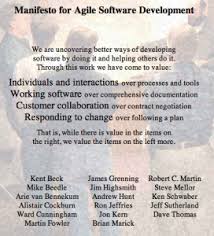The Benefits of Agile System Development
Agile system development is a methodology that emphasizes flexibility, collaboration, and continuous improvement in the software development process. Unlike traditional waterfall methods, agile approaches break down projects into smaller, manageable chunks called sprints, allowing for faster delivery of working software and more frequent feedback from stakeholders.
One of the key benefits of agile system development is its adaptability to changing requirements. By prioritizing close collaboration between developers and stakeholders, agile teams can quickly respond to new insights or shifting priorities, ensuring that the final product meets the evolving needs of the business.
Another advantage of agile methodologies is improved transparency and visibility throughout the development cycle. Regular meetings such as daily stand-ups and sprint reviews keep team members aligned on project goals and progress, fostering a culture of accountability and shared responsibility.
Agile system development also promotes a customer-centric approach by encouraging early and frequent feedback from end users. This iterative process allows for early detection of issues or opportunities for enhancement, leading to higher-quality software that better aligns with user expectations.
In addition to enhancing product quality and customer satisfaction, agile methodologies can also boost team morale and productivity. By empowering team members to make decisions collaboratively and providing a framework for continuous learning and improvement, agile practices create a more engaging and fulfilling work environment.
In conclusion, agile system development offers numerous benefits for organizations seeking to deliver high-quality software efficiently and effectively. By embracing agility, adaptability, and collaboration, businesses can accelerate their digital transformation efforts and stay ahead in today’s rapidly evolving market landscape.
Understanding Agile System Development: Key Principles, Benefits, and Transition Strategies
- What is agile system development?
- What are the key principles of agile methodology?
- How does agile system development differ from traditional waterfall methods?
- What are the benefits of adopting an agile approach to software development?
- How do agile teams prioritize work and manage project timelines?
- What role does continuous feedback play in agile system development?
- How can organizations transition to agile methodologies from their current development practices?
- What are some common challenges faced by teams implementing agile system development?
What is agile system development?
Agile system development is a methodology in software development that prioritizes flexibility, collaboration, and iterative progress. Unlike traditional waterfall approaches, agile methods involve breaking down projects into smaller increments or sprints, allowing for quicker delivery of functional software and continuous feedback from stakeholders. This iterative process enables teams to adapt to changing requirements, enhance transparency, and maintain a customer-centric focus by incorporating feedback early and often. Overall, agile system development emphasizes responsiveness to change, close collaboration among team members, and a commitment to delivering high-quality software that meets evolving business needs.
What are the key principles of agile methodology?
The key principles of agile methodology encompass a customer-centric approach, iterative development, collaboration, adaptability to change, and a focus on delivering working software. By prioritizing customer satisfaction through early and continuous delivery of valuable software, embracing flexibility to respond to changing requirements, fostering collaboration among cross-functional teams, and promoting adaptive planning and continuous improvement, agile methodologies enable organizations to effectively navigate complex projects and deliver successful outcomes that align with business objectives.
How does agile system development differ from traditional waterfall methods?
Agile system development differs significantly from traditional waterfall methods in its approach to software development. Unlike the linear and sequential nature of waterfall, agile is iterative and incremental, breaking down projects into smaller, manageable chunks called sprints. This allows for continuous feedback, adaptation to changing requirements, and faster delivery of working software. Agile emphasizes collaboration, flexibility, and customer involvement throughout the development process, whereas waterfall follows a rigid plan-driven approach with limited opportunities for course correction once the project has started. Overall, agile promotes a more adaptive and customer-centric mindset compared to the more structured and predictive nature of traditional waterfall methods.
What are the benefits of adopting an agile approach to software development?
Adopting an agile approach to software development offers a multitude of benefits for organizations looking to enhance their project outcomes. One key advantage is the increased flexibility and adaptability that agile methodologies provide, allowing teams to respond swiftly to changing requirements and market dynamics. By breaking down projects into manageable iterations, agile fosters a more collaborative and responsive environment, leading to faster delivery of high-quality software. Moreover, the iterative nature of agile development enables continuous feedback from stakeholders, ensuring that the final product aligns closely with user needs and expectations. Overall, embracing an agile approach can result in improved project visibility, enhanced team productivity, and ultimately, greater customer satisfaction.
How do agile teams prioritize work and manage project timelines?
In agile system development, teams prioritize work and manage project timelines through collaborative planning and iterative processes. Agile teams typically use techniques such as user stories, backlog grooming, and sprint planning to identify and prioritize tasks based on their value to the project and the needs of stakeholders. By breaking down project requirements into smaller, manageable chunks, teams can focus on delivering high-priority features in short development cycles called sprints. Regular monitoring of progress during daily stand-up meetings and retrospective sessions allows teams to adjust timelines and priorities as needed, ensuring that they stay on track to meet project goals effectively. This adaptive approach enables agile teams to respond quickly to changes, optimize resources, and deliver value incrementally throughout the development process.
What role does continuous feedback play in agile system development?
Continuous feedback plays a critical role in agile system development by enabling teams to gather insights, validate assumptions, and make informed decisions throughout the software development process. By seeking feedback from stakeholders, end users, and team members on a regular basis, agile teams can identify potential issues early, adjust their approach swiftly, and ensure that the final product meets the desired requirements. This iterative feedback loop not only enhances communication and collaboration within the team but also fosters a culture of continuous improvement and learning. Ultimately, continuous feedback in agile system development helps teams deliver high-quality software that aligns with business goals and user expectations effectively.
How can organizations transition to agile methodologies from their current development practices?
Organizations looking to transition to agile methodologies from their current development practices can follow a structured approach to ensure a smooth and successful transformation. It is essential to start by fostering a culture of openness and collaboration within the organization, encouraging team members to embrace change and adopt agile principles. Providing comprehensive training and resources on agile practices and frameworks is crucial to equip employees with the necessary skills and knowledge. Additionally, organizations should gradually introduce agile concepts through pilot projects or small teams to test the waters and gain valuable insights before scaling up across the entire organization. Regular communication, feedback loops, and continuous improvement are key components of a successful transition to agile methodologies, enabling organizations to adapt quickly, deliver value incrementally, and drive innovation in their software development processes.
What are some common challenges faced by teams implementing agile system development?
Teams implementing agile system development often encounter several common challenges that can impact the success of their projects. One prevalent issue is the resistance to change within organizations, as transitioning to an agile mindset requires a shift in traditional project management practices and team dynamics. Additionally, maintaining effective communication and collaboration among team members, stakeholders, and product owners can be a challenge, especially in distributed or cross-functional teams. Ensuring consistent prioritization of tasks and managing evolving requirements throughout the development process can also pose difficulties for agile teams. Overcoming these challenges requires a commitment to continuous improvement, flexibility, and a shared understanding of agile principles among all team members.




